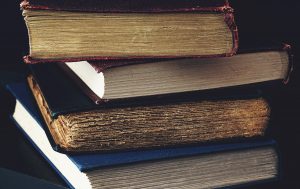
Stacked Books by Suzy Hazelwood licensed under Pexels
- What is a special collections library?
A special collections library is one that houses and preserves rare and archival materials and collections. One of the main things that set apart special collections from general collections is that the materials generally do not circulate. This isn’t too keep people from accessing them, but rather to ensure that materials are kept in safe conditions. At UNT, our Special Collections include rare books, oral histories, university archives, historical manuscripts, maps, microfilm, photographs, art, and artifacts.
- I was surprised to see there are items in the collection one would not normally expect, such as items that are not old, or items that are not even books. Could you talk more about that?
There are a ton of items in our collection that fall outside of those categories! We have toys, games, comics, art, posters, maps, clothing, posters, buttons, quilts, and even the odd hamster skull and preserved gecko. One of our more popular collections, particularly when it comes to class visits, is our Photography Study Collection. We have a growing collection of prints, portfolios, and books by notable modern and contemporary photographers. Several of the artists in the collection have works also owned by major museums and institutions – so it really is a unique opportunity to view them together and isn’t something many would expect us to own.
- Is there an item in the collection that is very popular among patrons?
I don’t know if I would say there is a particular item, but everyone seems to really enjoy looking at our Miniature Book collection. We have over 3,000 items in that collection, all of which are books under 4” in height. A large number of these miniatures are on display in the Hughes Reading Room and include antique miniatures, fine press miniatures, artists’ books, propaganda miniatures, mass-market miniatures, Texana miniatures, and several miniatures that were at one point considered “the smallest book in the world.” It’s definitely worth checking out if you haven’t had the opportunity, and it’s actually the collection that brought me to UNT Special Collections for the first time as an MLS graduate student.
- Who can use UNT’s special collections library? Do those who wish to visit need to make an appointment?
Anyone can visit and use UNT’s Special Collections library! You don’t have to be a researcher or even a member of the UNT community to come visit. We have an exhibition space in our Reading Room that holds semester long exhibits as well as our Miniature Books display that is available to be viewed by anyone and everyone during our open hours. However, if you’re interested in requesting materials, the timeline is a little different. We have a small space onsite where we keep some of our more popular items and collections, but most of our materials are stored offsite. Because of this, there’s generally a 24-48 hour wait time between when a request is submitted and when it is available to be viewed. Once the material is onsite and available though, no appointment is needed to come in and view it.
- Do you have advice for students who are interested in utilizing special collections for their research but don’t know where to begin?
My best advice is to reach out to us. Conducting research with primary sources and other special collections materials is a learned skill that takes practice, and we understand that. Our staff is always happy to meet with researchers and assist them with everything from how to locate materials in the catalog and our finding aids to showing them best practices when it comes to viewing, handling, and understanding materials.
- When I was doing research for this interview, I noticed a lot of articles talking about the importance of primary sources. Could you maybe expand on what those are and how it applies to special collections?
Primary sources provide raw information on people, places, and events, which is why archival materials such as correspondence, scrapbooks, records, journals, and other similar items are considered so important to scholars and their research. Special collections and archives everywhere work to make sure these items are preserved and cared for because, without them, we would lose those first-hand accounts and insights into the past.
- Is there anything else you think students should know about special collections?
Please come check us out! Next time you’re in the library or have a few minutes to spare between classes we’d love to see you. We have an amazing student-staffed service desk that’s always excited to tell you more about our collections, help you request or access materials, and show you around the reading room.
If you have any additional questions contact AskUs@unt.edu, or contact Special Collections directly at SpecialCollections@unt.edu.
Will you start using this library service? Comment down below!



Leave a Reply